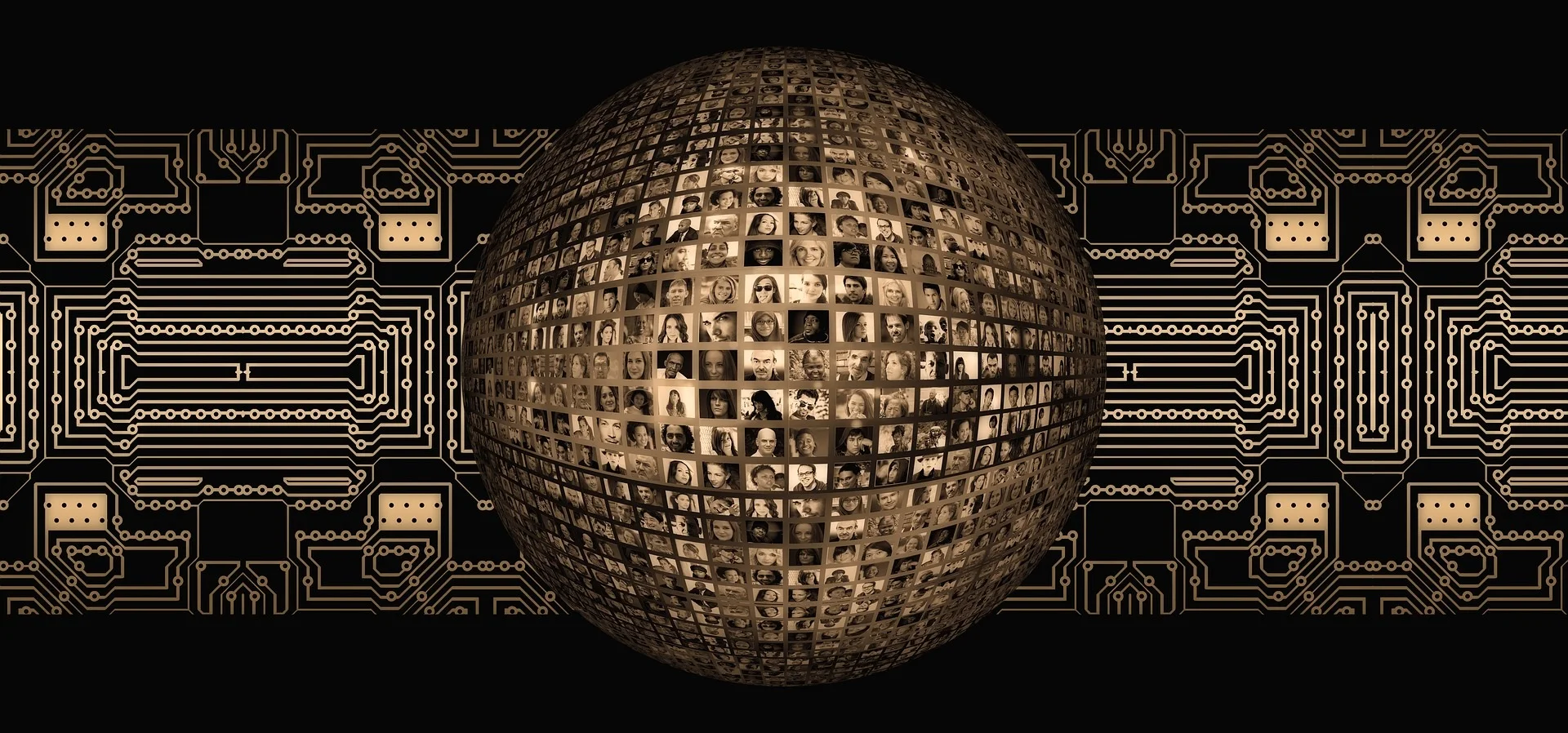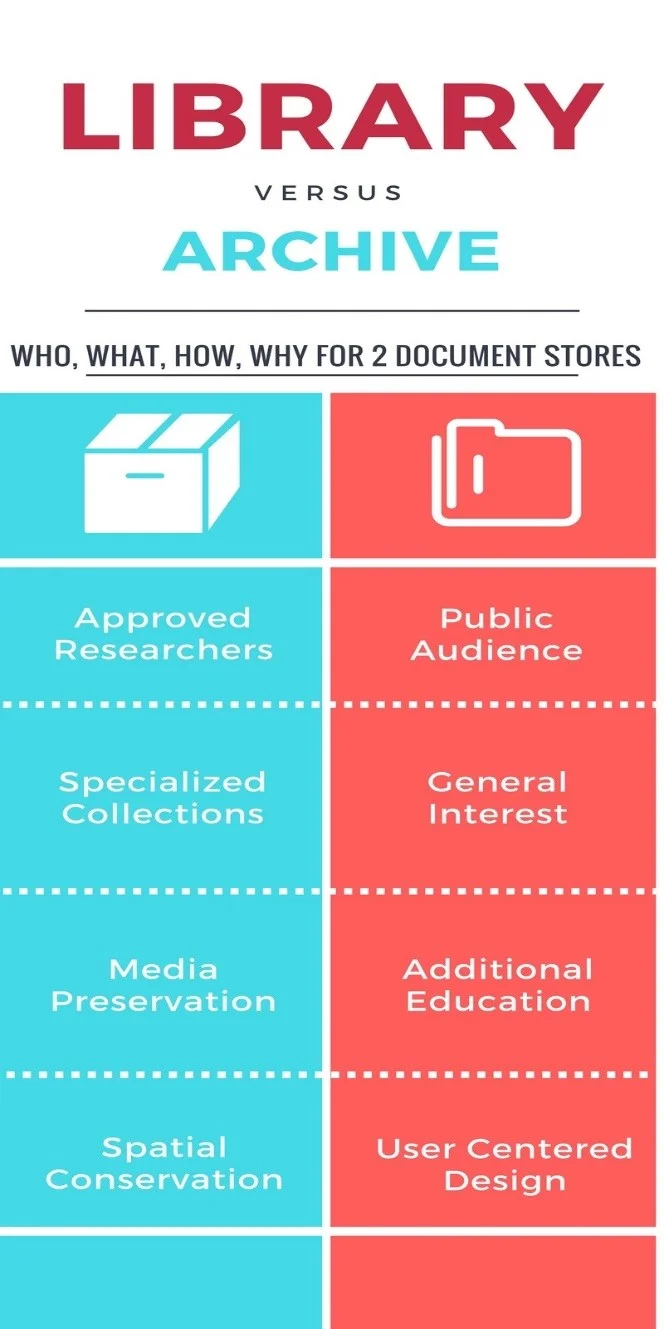Archives are very similar to libraries, however, they are often utilized far below their potential. Archives focus on the privacy of their stakeholders, not wanting to expose their collections to any risk. Archives also generally prioritize collections over visitors and are often organized according to grouped categories of media, many of which are unconventional. Because of similarities in software, cataloging, digitization techniques, and systems of collections management, digital collections are often grouped together and managed apart from the larger archive. Library attendance has shifted in tandem with population growth, especially with alternative programming, and National Archive participation is also significant. However, attendance at other archive’s is not well documented or published and virtual attendance is hardly tracked.
Infographic by Author
In trying to: demonstrate relevance in their community, compete with other archives, and grow their list of supporters, the United States Library of Congress (LOC) launched Labs in September 2017. LOC, in their ongoing initiative of open-sourced digitization, hopes to leverage their collections in novel and surprising ways while improving the degree of service offered to people who still visit in person. These actions follow the trend of institutions who are increasing collection accessibility in the pursuit of information democratization and open-sourced digitization. This is in contrast to many similarly-old collecting institutions, with origins predating digitization, that are often criticized for the innovation of their archives.
Library of Congress Labs is their virtual-user experiment space for exploring digital resources. “Labs.” Library of Congress. 2018. Accessed March 30, 2018. https://labs.loc.gov/.
An obstacle to an archive’s innovation appears when too much information is aggregated in one place. Administrative systems to manage these collections become wider and more encompassing to represent everything. Researchers, following through a centralized directory, will likely encounter cryptically symbolized methods of cataloging, making it hard to know or find what they would benefit from knowing. This experience can be intimidating to an unseasoned researcher, further discouraging the risk-taking and time investment required to study. Thereby, many researchers prefer to travel farther to more specialized collections because they are smaller. Digitization circumvents these hindrances to research and leads to more accelerated innovation through user-targeted research science.
Flowchart by Author
Library of Congress is America’s largest library, containing over 164 million books, recordings, photographs, newspapers, maps, and manuscripts that document America’s culture, both domestic and foreign. Its priority of collections stewardship is access for the United States Congress, followed by the rest of the federal government, then its citizens. LOC has been loyal to this directive since first organizing in the 19th century. As a library, it does not circulate its collection but is open to visitors who may study onsite and participate in events and it offers several services for publishers, researchers, and educational institutions. It is also the research division for Congress and home of the U.S. Copyright Office.
“Collections as Data: IMPACT.” Library of Congress. July 25, 2017. Accessed March 30, 2018. http://digitalpreservation.gov/meetings/asdata/impact.html.
July 25th, 2017, Library of Congress hosted a public conference “Collections as Data: Impact” to discuss digital collections’ role in expanding scholarship through computational analysis, a part II to a conference that occurred a year prior. Each presentation subscribed to the belief that information technology is readily adopted by most audiences. Despite the ambition represented in these cases, the problem remained in researchers’ ability to use accessible data productively. The potential solution, announced in the session’s opening remarks, was the Library of Congress's new, collaborative, online lab space that opened September 19th. This project demonstrates LOC’s commitment to using data stored in and generated through archives to encourage innovative research from their existing visitors with a goal to obtain new ideas from different audiences.
Data Migration Plan diagram from Library of Congress Labs' Pilot Project. Chudnov, Daniel and Michelle Gallinger. “Library of Congress Lab Report.” Library of Congress Digital Preservation. December 21, 2016. Accessed March 30, 2018. http://digitalpreservation.gov/meetings/dcs16/DChudnov-MGallinger_LCLabReport.pdf.
Spearheaded by Kate Zwaard, Chief of National Digital Initiatives, LOC Labs is designed according to principles of systems-thinking. An application programming interface, hosting time-specific experiments, is formatted as a minimum viable product to encourage modification and reproduction. One feature, reached through labs.loc.gov, is Beyond Words, which crowdsources the identification and captioning of cartoons and photographs in historic newspapers. Users self-order according to tasks of either selecting, transcribing, or verifying the digital records. This process grows the reach of available text datasets accessible online while also contributing to the collection of public use images for digital curation. Narrow in scope, this sub-project targets an audience with this specialized interest, time, and knowledge and who may already have experience in this capacity with the archive. However, this started as a pilot-project to help understand online research motivations and behaviors to further automate access.
Screenshot from Beyond Words, crowd-sourced image selection, transcription, and verification. “Beyond Words.” Library of Congress Labs. April 2018. Accessed April 17, 2018. http://beyondwords.labs.loc.gov/#/transcribe?group_id=59b3211fdb577d006c04a752.
LOC's ongoing offerings to other audiences include: temporary experiments for engagement, code and data for analytics, and hosted events with blogs and formal reporting to support these projects. At the time of this report, some of these experiments include a data contest, community share-board, collection search tools, and other special interest narratives that change frequently under the advisement of LOC Lab’s employees, interns, innovators in residence, and users. The premise of these sub-projects is to explore how to implement computation for new knowledge from old collections and enable gaming methodology for its online platforms. Archives are meant to preserve objects, meaning they don’t change, however, because people and society change in relation to these objects, there are new things to learn from them. Hosted online, the archive project selection is designed to be ephemeral, ever changing its experiments, projects, events, and resources to encourage creative public use of the library’s collections.
Resources:
“About the Library.” Library of Congress. 2018. Accessed March 30, 2018. https://www.loc.gov/about/.
Ashenfelder, Mike. “Helping Congress Archive Their Personal Digital Files.” Library of Congress. April 27, 2015. Accessed April 18, 2018. https://blogs.loc.gov/thesignal/2015/04/archiving-the-personal-digital-documents-of-congress/.
“Beyond Words.” Library of Congress Labs. April 2018. Accessed April 17, 2018. http://beyondwords.labs.loc.gov/#/transcribe?group_id=59b3211fdb577d006c04a752.
Chudnov, Daniel and Michelle Gallinger. “Library of Congress Lab Report.” Library of Congress Digital Preservation. December 21, 2016. Accessed March 30, 2018. http://digitalpreservation.gov/meetings/dcs16/DChudnov-MGallinger_LCLabReport.pdf.
“Collections as Data: IMPACT.” Library of Congress. July 25, 2017. Accessed March 30, 2018. http://digitalpreservation.gov/meetings/asdata/impact.html.
“Collections as Data: Stewardship and Use Models to Enhance Access.” Library of Congress Digital Preservation. September 27, 2016. Accessed March 30, 2018. http://digitalpreservation.gov/meetings/dcs16.html.
“Collections as Data 2017: Kate Zwaad.” Library of Congress. 2018. Accessed March 30, 2018. http://digitalpreservation.gov/meetings/asdata/bio_zwaard.html.
Dearstyne, Bruce W. “What is the Use of Archives? A Challenge for the Profession.” American Archivist. 1987. Accessed April 6, 2018. http://americanarchivist.org/doi/pdf/10.17723/aarc.50.1.572q383767657258?code=same-site.
Fay, Brigham. “Librarian of Congress visits MIT.” MIT Libraries. October 5, 2017. Accessed March 30, 2018. https://libraries.mit.edu/news/librarian-congress-visits/26045/.
“Labs.” Library of Congress. 2018. Accessed March 30, 2018. https://labs.loc.gov/.
Leetaru, Kalev. “The Library of Congress in the Digital Age: From Archiving Twitter To Innovation Lab.” Forbes. December 28, 2017. Accessed March 30, 2018. https://www.forbes.com/sites/kalevleetaru/2017/12/28/the-library-of-congress-in-the-digital-age-from-archiving-twitter-to-innovation-lab/#76ae0511e873.
“Library Launches labs.loc.gov.” Library of Congress. September 19, 2017. Accessed March 30, 2018. https://www.loc.gov/item/prn-17-129/library-launches-labs-loc-gov/2017-09-19/.
Morales, Macey. “New data on U.S. libraries shows almost two billion served.” American Library Association. April 16, 2007. Accessed April 6, 2018. https://www2.archivists.org/groups/archives-management-section.
“Strategic Plan: FY 2016 through FY 2020.” Library of Congress. 2015. Accessed March 30, 2018. https://www.loc.gov/portals/static/about/documents/library_congress_stratplan_2016-2020.pdf.
“Technical Information; About American Memory.” Library of Congress. 2018. Accessed April 18, 2018. https://memory.loc.gov/ammem/about/techIn.html.
“What Are Archives and How Do They Differ from Libraries?” Society of American Archivists. 2018. Accessed April 6, 2018. https://www2.archivists.org/usingarchives/whatarearchives.
"Why Visit The National Archives?" National Archives. September 16, 2016. Accessed April 18, 2018. https://www.archives.gov/locations/why-visit.






